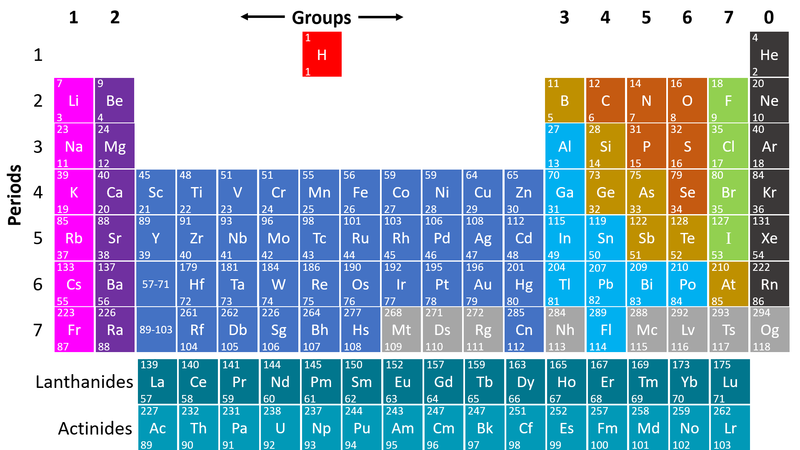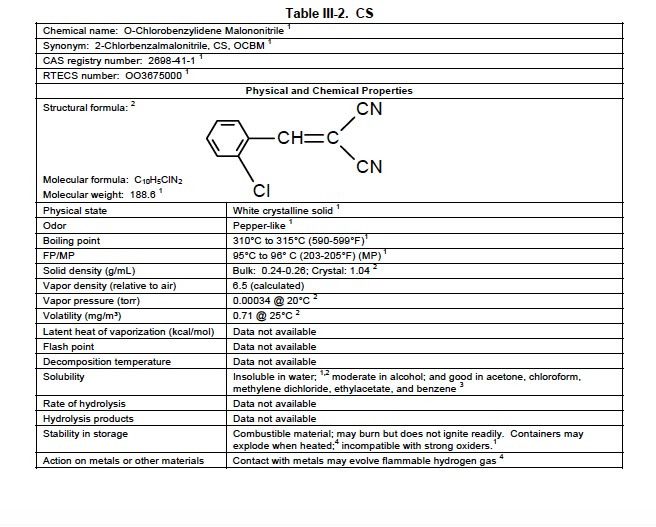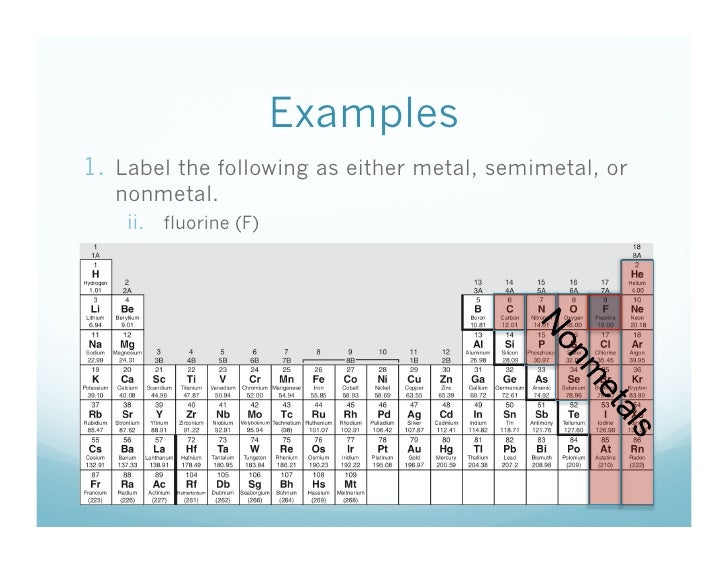41 periodic table with metal and nonmetal labels
Labeled Periodic Table of Elements with Names - Science Struck Non-Metals: Hydrogen, Carbon, Nitrogen, Oxygen, Phosphorus, Sulfur and Selenium are seven non-metals located in the 14th, 15th and 16th group of the periodic table. These elements are very brittle and do not easily conduct electricity. Noble Gases: Noble gases are located in 18th group of the periodic table. Helium, Neon, Argon, Krypton, Xenon ... Metal and non-metal oxides - The periodic table - BBC Bitesize Metals are on the left of the periodic table, and non-metals are on the right Oxides are substances made of two or more types of chemically bonded together. All are compounds, and contain a single...
Metals, Non-Metals and Metalloids - GeeksforGeeks Metals, non-metals, and metalloids are the most common elements. Compounds, on the other hand, are pure entities formed by the chemical combination of two or more elements in a predetermined ratio. Chemical procedures, on the other hand, can break down these compounds into individual elements. e.g. gold, copper, oxygen, chlorine, diamond, etc.

Periodic table with metal and nonmetal labels
The Periodic Table | CHEM 1305: General Chemistry I—Lecture - Course Hero Metal or Nonmetal? Using the periodic table, classify each of the following elements as a metal or a nonmetal, and then further classify each as a main-group (representative) element, transition metal, or inner transition metal: uranium; bromine; strontium; neon; gold; americium; rhodium; sulfur; carbon; potassium Metals and Non Metals of the Periodic Table The periodic table can be separated into two large sections. Primarily the metals and non-metals, these are separated by the stairs of metalloids from Boron to Astatine. Most metals are solids and non-metals are liquids and gases. There are of course some exceptions to this. Metals are predominantly located on the left of the periodic table. The Periodic Table Of Metals And Nonmetals | Science Trends The periodic table of metals and nonmetals can be broken down to give you a sense of each ...
Periodic table with metal and nonmetal labels. The Periodic Table | General Chemistry - Lumen Learning Groups are labeled at the top of each column. In the United States, the labels traditionally were numerals with capital letters. However, IUPAC recommends that the numbers 1 through 18 be used, and these labels are more common. ... Metal or Nonmetal? Using the periodic table, classify each of the following elements as a metal or a nonmetal, and ... Blocks of the Periodic Table: s-block, p-block, d-block, f-block Also, read about Trends in Periodic Table, here. Non - Metals Non-metals are located at the top right-hand side of the Periodic Table. In a horizontal row, the property of elements changes from metallic on the left to non-metallic on the right. Non-metals are usually solids or gases at room temperature with low melting and boiling points. Periodic Table/Metals/Nonmetals Quiz - Quizizz D. Question 10. 30 seconds. Q. A student tested the conductivity of four elements using an incomplete electrical circuit. When the element is placed in the circuit, the bulb lights up brightly, lights up dimly, or does not light up at all based on the element's ability to conduct electricity. The table below shows the results of her ... Properties of Periodic Table of Element Groups - ThoughtCo Alkali Metals. Less dense than other metals. One loosely bound valence electron. Highly reactive, with reactivity increasing moving down the group. The largest atomic radius of elements in their period. Low ionization energy. Low electronegativity.
Metalloid - Wikipedia Recognition status, as metalloids, of some elements in the p-block of the periodic table. Percentages are median appearance frequencies in the lists of metalloids. The staircase-shaped line is a typical example of the arbitrary metal–nonmetal dividing line found on some periodic tables. Different Types of Metals on the Periodic table (With Image) There are total 17 Rare Earth metals on the Periodic table. Rare Earth Metals includes all the 15 Lanthanides as well as scandium (Sc) and yttrium (Y). So total 15 + 2 = 17 Rare Earth metals. If you are thinking that rare earth metals are those types of metals on Periodic table which are very rarely available, then you are WRONG. What are metals and nonmetals on the periodic table? - FAQs The metals list which makes up the periodic table includes iron, lead, gold, aluminum, platinum, uranium, zinc, lithium, sodium, tin, silver, etc. The nonmetals list which makes up the periodic table includes hydrogen, helium, carbon, sulfur, nitrogen, oxygen, radon, neon, other halogens, and noble gases etc. 10 List of Metals - Science Notes and Projects Location of Metals on the Periodic Table. Over 75% of the elements are metals, so they fill most of the periodic table. Metals are on the left side of the table. The two rows of elements below the main body of the table (the lanthanides and actinides) are metals. Uses of Metals. Metals find use in every aspect of life. Here is a list of some of ...
Groups and Periods of the Periodic Table --------------------Metals ... The metals are subdivided into the highly reactive alkali metals, through the less reactive alkaline earth metals, lanthanides and actinides, via the archetypal transition metals, and ending in the physically and chemically weak post-transition metals. The nonmetals are simply subdivided into the polyatomic nonmetals which, being nearest to the metalloids, show some incipient metallic character; the diatomic nonmetals, which are essentially nonmetallic; and the monatomic noble gases, which ... Metals, Nonmetals, and Metalloids of the Periodic Table - ThoughtCo The metalloids separate the metals and nonmetals on a periodic table. Also, many periodic tables have a stair-step line on the table identifying the element groups. The line begins at boron (B) and extends down to polonium (Po). Elements to the left of the line are considered metals. Elements just to the right of the line exhibit properties of both metals and nonmetals and are termed metalloids or semimetals. Periodic Table of the Elements - Metals Hard, shiny, malleable. meaning flexible. Metals are. ductile. , can be pulled thinner and longer without breaking. Metals are good conductors of electricity because the free electrons can move around freely within the metal. Metals like iron (Fe), copper (Cu), aluminum (Al) and gold (Ag) are often used in electronic cables and electrical ... Periodic table labeled with Metals Nonmetals and Metalloids Periodic table labeled with Metalloids Above picture shows you the labeled Metalloids on the Periodic table. They are found between the metals and nonmetals. Elements which have the metallic properties as well as nonmetallic properties are classified as Metalloids. Because of this reason, they are also known as semimetals.
PDF Metals, Non-Metals, Metalloids and the Periodic Table The Metals are represented in the Periodic Table in blue. The Periodic Table H He Li Be B C N O F Ne Na Mg Al Si P S Cl Ar K Ca Sc Ti V Cr Mn Fe Co Ni Cu Zn Ga Ge As Se Br Kr ... The Non-Metals are represented in the Periodic Table in yellow. The Periodic Table H He Li Be B C N O F Ne Na Mg Al Si P S Cl Ar K Ca Sc Ti V Cr Mn Fe Co Ni Cu Zn Ga ...
3 Minerals – An Introduction to Geology Derive basic atomic information from the Periodic Table of Elements. Describe chemical bonding related to minerals. Describe the main ways minerals form. Describe the silicon-oxygen tetrahedron and how it forms common silicate minerals. List common non-silicate minerals in oxide, sulfide, sulfate, and carbonate groups.
The Periodic Table: Metals, Nonmetals, and Metalloids Using the periodic table, you can classify the elements in many ways. One useful way is by metals, nonmetals, and metalloids. The periodic table is organized in families and periods. Metals In the periodic table, you can see a stair-stepped line starting at Boron (B), atomic number 5, and going all the way down to Polonium (Po), atomic number 84.
Metals, Nonmetals, and Metalloids on the Periodic Table A description and practice of finding metals, nonmetals, and metalloids on the Periodic Table.In general metals are found on the left-hand side of the period...

Draw a part of the long form of periodic table showing a non metal surrounded by non metals from ...
Elements and The Periodic Table | CHEM 1305 Introductory Chemistry ... Using the periodic table, classify each of the following elements as a metal or a nonmetal, and then further classify each as a main-group (representative) element, transition metal, or inner transition metal: cobalt; europium; iodine; indium; lithium; oxygen; cadmium; terbium; rhenium
Nonmetal - Wikipedia In periodic table terms, an analogy can be drawn between the noble gases and noble metals such as platinum and gold, with the latter being similarly reluctant to enter into chemical combination. As a further example, xenon, in the +8 oxidation state, forms a pale yellow explosive oxide, XeO 4 , while osmium , another noble metal, forms a yellow ...
Periodic Table of Elements - PubChem Such was the case when IUPAC recently reviewed elements 113, 115, 117 and 118, and decided to give them official names and symbols (goodbye, ununseptium and hello, tennessine!). Atomic weights found within a periodic table one might think are constant. The truth is that atomic weights have changed as a function of time.
(PDF) general-chemistry.pdf | Sumit Banerjee - Academia.edu general-chemistry.pdf
Periodic Table of Elements: Los Alamos National Laboratory The alkali metals make up group 1 of the Table, and comprise Li through Fr. They have very similar behavior and characteristics. Hydrogen is group 1 but exhibits few characteristics of a metal and is often categorized with the nonmetals. Alkaline earth metals. The alkaline earth metals make up group 2 of the periodic table, from Be through Ra.
1910.1450 App A - National Research Council Recommendations ... The CSB issued a case study on an explosion at Texas Tech University in Lubbock, Texas, which severely injured a graduate student handling a high-energy metal compound. Since 2001, the CSB has gathered preliminary information on 120 different university laboratory incidents that resulted in 87 evacuations, 96 injuries, and three deaths.
Labeled Periodic Table | Science Trends One way that the elements of the periodic table are grouped together is through various properties that classify them one of three different groups: metals, metalloids/semimetals, and nonmetals. Most of the elements found on the periodic table are metals, and metals are distinguished by properties like: Being shiny, having high luster
On Periodic Table Label Alkaline Earth Metals On Periodic Table Label Alkaline Earth Metals. Alkali alloys. The name alkali precious metals arises from the Arabic phrase al-qali, meaning ashes. These metals are most reactive when in contact withwater and air, or oil. They may be usually found in salts, and also have a body-focused cubic construction.
Labeled Periodic Table of Elements with Name [PDF & PNG] Periodic Table Labeled Groups There are 118 elements in the periodic table, out of which 94 elements are natural, and others are nuclear reactor or laboratory tested elements. There are 18 groups in the periodic table, which consists of metal and nonmetal. Protons in the tables are positively charged particles.
2018 INTERNATIONAL RESIDENTIAL CODE (IRC) - ICC User note: About this chapter: The purpose of Chapter 11 [RE] is to provide minimum design requirements that will promote efficient utilization of energy in buildings. The requirements are directed toward the design of building envelopes with adequate thermal resistance and low air leakage, and toward the design and selection of mechanical, water heating, electrical and illumination systems ...
Build an Atom - Atoms | Atomic Structure | Isotope Symbols ... Build an atom out of protons, neutrons, and electrons, and see how the element, charge, and mass change. Then play a game to test your ideas!
Periodic table label Flashcards | Quizlet Start studying Periodic table label. Learn vocabulary, terms, and more with flashcards, games, and other study tools. ... Metals are found on the _____ side of the periodic table. ... Right. Metalloids. Elements that have properties of both metals and nonmetals. 2 names for the vertical rows on the periodic table. Family/groups (there are 18) 2 ...
Metals and non-metals in the periodic table - The periodic table - AQA ... Metals are on the left of the periodic table, and non-metals are on the right. Atomic structure and the periodic table Elements in group 1 and group 2 are metals. Atoms of group 1 elements have one...
![QTR [Brainiac: Science Abuse]](https://blogger.googleusercontent.com/img/b/R29vZ2xl/AVvXsEgn-8EgFpfvirdulzwLBUaR6sddjZ_kgjWuc3ciW8k4n_S2pO8OhvQjNZh8D6h-Z2Oir6o1OLAKa9d9y2-J3QTB_33C7TJbOD-OCY5rNX5vgr1NAkUudiDA8fLHkdJNUW4p321EB6ji6nSU/s320/periodic+table.gif)









Post a Comment for "41 periodic table with metal and nonmetal labels"